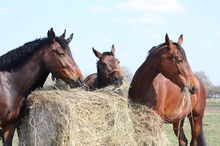Performance horses put a lot of strain on their legs as they run, jump, spin, pull carriages, or perform sliding stops from a full gallop. To keep your horseâs joints in the best condition for a long athletic career, follow these tips to preserve health and prevent discomfort or lameness.

Recognizing the importance of proper nutrition in equine health and welfare
Proper nutrition is key to overall health in horses and is a priority when it comes to keeping your horseâs joints in the best condition for a long athletic career.
Proper nutrition is key to overall health in horses. In young horses, feeding for smooth, gradual growth will help in the development of strong bones and healthy cartilage. Try to keep horses at an optimum weight since obesity increases the stress on joint structures, eventually leading to unsoundness in some horses.
Slow, steady training is important in keeping horses sound. Begin with short, easy exercise periods and increase the length and intensity of workouts over a period of several months. This type of conditioning allows the horseâs muscles, bones, heart, and lungs to adapt to the demands of performance. There is less chance of joint injury if the horse has the fitness level to perform without developing undue fatigue.
Allowing time forreconditioning after a layoff is important as well. If the horse is out of work for more than a few weeks, back off on the level of exercise when riding resumes, especially if the horse is recovering from an injury or illness. For an easy way to objectively measure the intensity and duration of your schooling sessions, check out the KER ClockIt⢠Sport mobile app.
Limit work on hard surfaces. Extreme concussion can damage joint cartilage, so riders should try to avoid long periods of galloping or jumping on hard, dry ground. For horses that are frequently ridden on pavement, padded boots can absorb some of the shock that is transmitted up the horseâs legs with each step.
Watch for early signs of joint problems such as heat, swelling, or lameness. If joint issues are diagnosed and treated in their initial stages, the chance for healing is enhanced and further damage may be avoided. Keep horses on a regular schedule of hoof care. Trimming and resetting of shoes will keep the horse balanced, avoiding unnecessary strain. Corrective trimming and shoeing can also help young horses overcome conformation faults that put extra stress on knees, hocks, and fetlocks.
Joint supplements like Synovate HA® and KERâ¢Flex® from Kentucky Equine Research may support joint health and extend the active years. Synovate HA delivers sodium hyaluronate, a structural component of joint cartilage and synovial fluid. KERâ¢Flex contains glucosamine HCl and chondroitin sulfate and is designed to assist in maintenance of joint integrity. It may also slow the progression of arthritic changes in older horses.
Omega-3 supplements are also useful for joints. EOâ¢3⢠is a rich source of omega-3 fatty acids DHA and EPA, compounds found to optimize the well-being of all horses. Specifically, DHA and EPA supplementation has been shown to reduce inflammation with osteoarthritis. Choose EOâ¢3 to promote a more natural balance of omega-3 to omega-6 fatty acids in the body and the benefits it can confer on joint health.
Wondering if these supplements would fit into your horseâs diet? Simply answer a few questions and a KER nutrition advisor will be in touch.
Kentucky Equine Research (KER) is an international equine nutrition, research and consultation company serving both the horse producer and the feed industry. Its goal is to advance the industry's knowledge of equine nutrition and exercise physiology and apply this knowledge to produce healthier, more athletic horses. For more information, see www.ker.com or call 888-873-1988.
